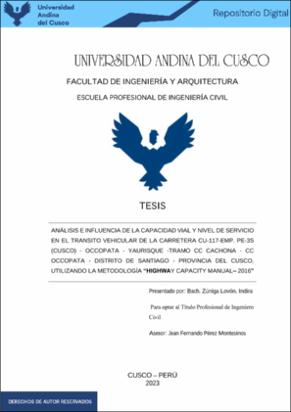| dc.contributor.advisor | Pérez Montesinos, Jean Fernando | |
| dc.contributor.author | Zúniga Lovón, Indira | |
| dc.date.accessioned | 2023-05-30T20:34:50Z | |
| dc.date.available | 2023-05-30T20:34:50Z | |
| dc.date.issued | 2022-12-09 | |
| dc.identifier.uri | https://hdl.handle.net/20.500.12557/5492 | |
| dc.description.abstract | La presente investigación tiene por objetivo principal emplear la metodología Highway Capacity
Manual (HCM) 2016, y los alcances del manual de conservación vial e inventarios viales del
ministerio de transportes y comunicaciones (DG-MTC 2018) para analizar la capacidad vial y nivel
de servicio de la carretera CU-117-EMP. PE-3S (CUSCO) – OCCOPATA - YAURISQUE – TRAMO CC
CACHONA – CC OCOCOPATA DEL DISTRITO DE SANTIAGO – PROVINCIA DEL CUSCO. Se realizó un
procedimiento de aforo para conocer el IMDA vehicular de la carretera en mención. Se analizó
el nivel de servicio y las características geométricas de la carretera. Se analizó la velocidad con la
que los vehículos transitan en la carretera, y finalmente se propone la mejora del diseño
geométrico para aumentar la capacidad vial y el nivel de servicio, aplicando la metodología HCM2016
y
parámetros de
la
normativa
peruana
DG-MTC
2018.
Los datos y cálculos realizados en la presente investigación pueden ser de utilidad para contribuir
al diseño y planeación de posibles intervenciones en la vía analizada. Se determinó que las
características de tránsito y las características físicas actuales satisfacen las condiciones de
operación, pero en una situación de equilibrio límite, con capacidades viales en el Tramo I y II de
986 veh/h y en el Tramo III de 841.5 veh/h, que se encuentran por debajo de la capacidad vial
básica (3200 veh/h); y un nivel de servicio E en los tres tramos, también, por debajo del nivel de
servicio ideal (A). Según la metodología empleada, se determinó que la carretera tiene un
pésimo diseño geométrico, ya que este no cumple con los mínimos estándares de velocidad y
capacidad para un buen funcionamiento. Utilizando la metodología HCM-2016 y los parámetros
de la Normativa Peruana se propuso una mejora del diseño geométrico para aumentar la
capacidad vial y el nivel de servicio. Los tres tramos de la carretera analizada que originalmente
fueron diagnosticados en nivel E fueron mejorados a nivel A y B. | es_PE |
| dc.description.abstract | The present research has a main objective to employ the Highway Capacity Manual (HCM) 2016
as well as the provisions indicated by the Manual of Highway Conservation and Highway Stock
of the Ministry of Transportation and Communications from Peru (DG-MTC 2018) for the analysis
of the highway capacity and the level of service of the Highway CU-117-EMP. PE-3S (CUSCO) –
OCCOPATA - YAURISQUE – TRAMO CC CACHONA – CC OCOCOPATA DEL DISTRITO DE SANTIAGO
– PROVINCIA DEL CUSCO. A gauging procedure was performed with the purpose to know the
Median Diary Index of Vehicles using the aforementioned highway. It was analysed the level of
service and the geometric features of the highway. Also, it was gathered information regarding
the velocity of the vehicles while transiting along the highway. Finally, it was proposed an
improvement of the geometric design with the purpose to increase the highway capacity and
the level of service by applicating the HCM 2016.
And the provisions provided by the Peruvian regulations. Data and calculus herein presented can
be useful for future design and planification of potential interventions in the highway. It was
determined that the characteristics of the traffic and the current physical conditions satisfy the
requirements for operation. However, these conditions are only viable with capacities of 986
veh/h and 841 veh/h in the sections I and II respectively. Also, a level of service E was found in
the three sections of the highway, which means a deficient service. According to the
methodology herein employed, it was determined that the highway has an appalling geometric
design, since it does not meet the minimum standard requirements for velocity and capacity
which leads to a good geometric design. Using the HCM 2016 methodology and the parameters
of the Peruvian regulations it was proposed an improvement of the geometric design which leads
to the increase of the highway capacity and the level of service. The three sections previously
analysed and diagnosticated as level E were improved to level A and B. | en_US |
| dc.format | application/pdf | es_PE |
| dc.language.iso | spa | es_PE |
| dc.publisher | Universidad Andina del Cusco | es_PE |
| dc.rights | info:eu-repo/semantics/openAccess | es_PE |
| dc.rights.uri | https://creativecommons.org/licenses/by-nc-nd/4.0/ | es_PE |
| dc.subject | Capacidad vial | es_PE |
| dc.subject | Nivel de servicio | es_PE |
| dc.subject | Velocidad | es_PE |
| dc.title | Análisis e influencia de la capacidad vial y nivel de servicio en el transito vehicular de la carretera cu-117-emp. pe-3s (Cusco) - Occopata - Yaurisque -Tramo Cc Cachona - Ccoccopata - distrito de Santiago - provincia del Cusco, utilizando la metodología “Highway capacity manual– 2016” | es_PE |
| dc.type | info:eu-repo/semantics/bachelorThesis | es_PE |
| thesis.degree.name | Ingeniero Civil | es_PE |
| thesis.degree.grantor | Universidad Andina del Cusco. Facultad de Ingeniería y Arquitectura | es_PE |
| thesis.degree.discipline | Ingeniería Civil | es_PE |
| dc.publisher.country | PE | es_PE |
| dc.subject.ocde | https://purl.org/pe-repo/ocde/ford#2.01.00 | es_PE |
| renati.advisor.dni | 40996943 | |
| renati.advisor.orcid | https://orcid.org/0000-0002-7566-1001 | es_PE |
| renati.author.dni | 73079943 | |
| renati.discipline | 732016 | es_PE |
| renati.juror | Gutierrez Vallejo, Heber Darwin | |
| renati.juror | Chipana Molina, Yimmy Johan | |
| renati.juror | Ríos Rabelo, José Luis | |
| renati.juror | Gutierrez Carlotto, Ed | |
| renati.level | https://purl.org/pe-repo/renati/level#tituloProfesional | es_PE |
| renati.type | https://purl.org/pe-repo/renati/type#tesis | es_PE |


